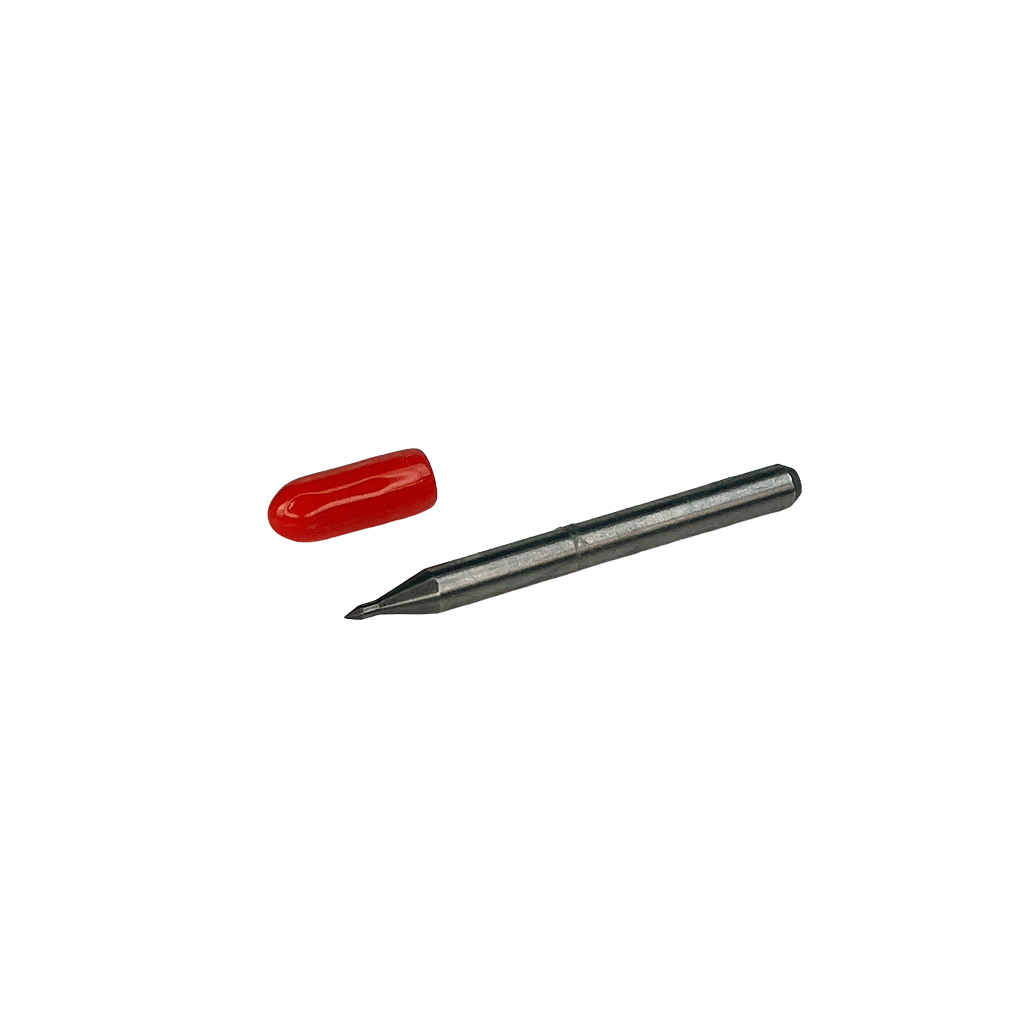Home Windshield Repair Products Accessories Carbide Replacement Point for 22100 Scribe
$4.20
In Stock
Carbide Replacement Point for 22100 Scribe
96 in stock
Carbide replacement point (0.127 diameter) for 22100 Carbide Point Scribe.
From the Archives
Recently, we have received multiple phone calls from customers on the subject of repairing damage that has been repaired before. First off, it should be stated that windshield repair is a permanent process. However, fixing a botched job is sometimes possible but it is important to weigh the benefits vs. the drawbacks of taking on such a challenge.
There are several different challenges you may encounter when presented with a repair that has been attempted previously. As unbelievable as it is to true professionals, there are windshield repair technicians who only use high viscosity pit resin to repair a rock chip. If you run across this type of attempted repair, the air pocket in the damage will not look filled and there will only be a layer of resin on the top that is cured, but if a previous technician has used a low viscosity resin, more than likely the air pocket of the damage will be partially filled. If the damage appears partially filled and you have ruled out the possibility of liquid being present in the damage, you can be reasonably sure a repair attempt has been made.
Yellowing in the pit area is a good indicator that either the previous repair is of considerable age or a low quality resin product was used. When you inspect the damage (a must before attempting any repair) use a probe or scribe to clean out the impact point. The best way to determine if a repair has been previously attempted is by noting the difference between the glass and the resin (resin will be softer). Assess the damage and determine if a re-repair is in the best interest of the customer, then before initializing the re-repair, inform your customer of your suspicions regarding a previous repair attempt and set realistic expectations for the outcome.
If resin has previously been cured inside some of the air spaces, the next step is to drill into the largest air pocket in the damage. The goal is to inject resin into the areas that were not filled in the previous repair attempt, which may require drilling in multiple areas if the air pockets are not connected. Before you start the repair you need to ask yourself if the completed re-repair will be cosmetically acceptable to the customer or if it would be better to explain to the customer why you must decline the job.
In summary: Properly evaluating the damage to determine the likelihood of success prior to starting a re-repair is essential. If it is possible to access the unfilled air space without creating too much additional cosmetic damage, the chances of a successful re-repair are quite high. By contrast, if it is necessary to drill multiple holes to get the damage completely filled with resin, you are essentially creating additional cosmetic damage that may look unsatisfactory to your customer. Setting realistic expectations for the customer and knowing the limits of your skill set will determine how satisfied your customers will be with the quality of your work.
Only logged in customers who have purchased this product may leave a review.
This windshield repair training is a hands-on, intensive, one day course designed to take your repair quality to the next level. Whether you are just starting out or are a seasoned pro, this class is right for you!
Our team of experienced technicians are dedicated to offering the highest standard of training in the windshield repair industry. During the Delta Kits Training and Certification course, technicians are trained to follow ROLAGS (Repair of Laminated Auto Glass Standards), the industries best practices. Delta Kits Training and Certification covers all technical aspects of windshield repair and will take you from never having completed a repair, to being among the best technicians in the industry. The marketing and insurance billing discussion is designed to help you become more successful in your windshield repair business.

Brent Deines was originally trained by a Novus Methodman in 1987 and is NWRA certified. He has extensive experience repairing windshields and restoring headlights in a variety of climates and conditions. Deines has owned several auto glass repair and replacement businesses in Montana and Oregon and is currently the President and CEO of Delta Kits where he helped develop the company’s headlight restoration program and started the company’s windshield repair training and certification program in 1995.

Korey Gobin, Delta Kits sales manager, is NWRA certified and has been training individuals as well as large groups in the art of professional windshield repair and headlight restoration since 2008. Gobin is actively involved in the Repair of Laminated Automotive Glass Standard and in 2011 was awarded the Mobile Tech Windshield Repair Person of the Year. Korey serves on the ROLAGS committee and has traveled extensively throughout the USA, Canada, and Mexico to promote high-quality standards for windshield repair and headlight restoration. He is affectionately known by his customers as the “Go to Guy” for windshield repair.

Graham Watson, is one of the original Novus Technicians in the UK since 1988 and since then has been running a very successful windscreen repair service in the UK. In 2008 Graham was named Windshield Repair Person of the year at the Mobile Tech Expo, an award he is very proud of as it is voted for by his peers in the trade. For the past 10 years, Watson has been active training technicians for the repair industry and specializes in advanced training for techs with previous experience, during this time he has been lucky enough to work with people from many different countries. His passion for helping others carry out the best quality repairs possible shows in the time he spends offering advice on different trade forums as Screenman.
Carbide replacement point (0.127 diameter) for 22100 Carbide Point Scribe.
From the Archives
Recently, we have received multiple phone calls from customers on the subject of repairing damage that has been repaired before. First off, it should be stated that windshield repair is a permanent process. However, fixing a botched job is sometimes possible but it is important to weigh the benefits vs. the drawbacks of taking on such a challenge.
There are several different challenges you may encounter when presented with a repair that has been attempted previously. As unbelievable as it is to true professionals, there are windshield repair technicians who only use high viscosity pit resin to repair a rock chip. If you run across this type of attempted repair, the air pocket in the damage will not look filled and there will only be a layer of resin on the top that is cured, but if a previous technician has used a low viscosity resin, more than likely the air pocket of the damage will be partially filled. If the damage appears partially filled and you have ruled out the possibility of liquid being present in the damage, you can be reasonably sure a repair attempt has been made.
Yellowing in the pit area is a good indicator that either the previous repair is of considerable age or a low quality resin product was used. When you inspect the damage (a must before attempting any repair) use a probe or scribe to clean out the impact point. The best way to determine if a repair has been previously attempted is by noting the difference between the glass and the resin (resin will be softer). Assess the damage and determine if a re-repair is in the best interest of the customer, then before initializing the re-repair, inform your customer of your suspicions regarding a previous repair attempt and set realistic expectations for the outcome.
If resin has previously been cured inside some of the air spaces, the next step is to drill into the largest air pocket in the damage. The goal is to inject resin into the areas that were not filled in the previous repair attempt, which may require drilling in multiple areas if the air pockets are not connected. Before you start the repair you need to ask yourself if the completed re-repair will be cosmetically acceptable to the customer or if it would be better to explain to the customer why you must decline the job.
In summary: Properly evaluating the damage to determine the likelihood of success prior to starting a re-repair is essential. If it is possible to access the unfilled air space without creating too much additional cosmetic damage, the chances of a successful re-repair are quite high. By contrast, if it is necessary to drill multiple holes to get the damage completely filled with resin, you are essentially creating additional cosmetic damage that may look unsatisfactory to your customer. Setting realistic expectations for the customer and knowing the limits of your skill set will determine how satisfied your customers will be with the quality of your work.
There are no reviews yet.
Only logged in customers who have purchased this product may leave a review.
This windshield repair training is a hands-on, intensive, one day course designed to take your repair quality to the next level. Whether you are just starting out or are a seasoned pro, this class is right for you!
Our team of experienced technicians are dedicated to offering the highest standard of training in the windshield repair industry. During the Delta Kits Training and Certification course, technicians are trained to follow ROLAGS (Repair of Laminated Auto Glass Standards), the industries best practices. Delta Kits Training and Certification covers all technical aspects of windshield repair and will take you from never having completed a repair, to being among the best technicians in the industry. The marketing and insurance billing discussion is designed to help you become more successful in your windshield repair business.

Brent Deines was originally trained by a Novus Methodman in 1987 and is NWRA certified. He has extensive experience repairing windshields and restoring headlights in a variety of climates and conditions. Deines has owned several auto glass repair and replacement businesses in Montana and Oregon and is currently the President and CEO of Delta Kits where he helped develop the company’s headlight restoration program and started the company’s windshield repair training and certification program in 1995.

Korey Gobin, Delta Kits sales manager, is NWRA certified and has been training individuals as well as large groups in the art of professional windshield repair and headlight restoration since 2008. Gobin is actively involved in the Repair of Laminated Automotive Glass Standard and in 2011 was awarded the Mobile Tech Windshield Repair Person of the Year. Korey serves on the ROLAGS committee and has traveled extensively throughout the USA, Canada, and Mexico to promote high-quality standards for windshield repair and headlight restoration. He is affectionately known by his customers as the “Go to Guy” for windshield repair.

Graham Watson, is one of the original Novus Technicians in the UK since 1988 and since then has been running a very successful windscreen repair service in the UK. In 2008 Graham was named Windshield Repair Person of the year at the Mobile Tech Expo, an award he is very proud of as it is voted for by his peers in the trade. For the past 10 years, Watson has been active training technicians for the repair industry and specializes in advanced training for techs with previous experience, during this time he has been lucky enough to work with people from many different countries. His passion for helping others carry out the best quality repairs possible shows in the time he spends offering advice on different trade forums as Screenman.

$4.20
Reviews
There are no reviews yet.